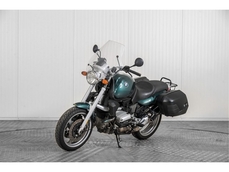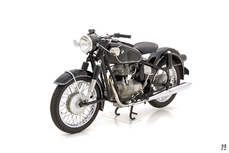BMW Other 1950
Allgemeine Beschreibung :
Late in the 1930s, Germany's powerful propaganda machine took on the world of motor racing, throwing untold resources toward utter domination of the sport. Government-backed Grand Prix teams from Mercedes-Benz and Auto Union operated with virtually unlimited budgets, and the cars they produced were marvels of technical sophistication, overwhelming the competition in the process. In sports car racing, BMW briefly achieved similar status, particularly in the 2-liter classes, where their light and nimble 328 was the only car to have if you wanted a chance at winning. They even beat the Italians on sacred ground, winning the 1940 Mille Miglia in a streamlined 328 built especially for the event. But after the war, German motorsport was an altogether different scene. The cars that dominated the pre-war events were locked away, destroyed, or broken up for parts. The legendary Nurburgring Nordschliefe became overgrown, and the surface torn up by tank tracks. But racers are nothing if not persistent, and clubs soon regrouped, cleaned up circuits, and began trading food and cigarettes for spark plugs, spare parts, and fuel.
For the German motor industry, sports cars were the last things on their minds. Material shortages and rationing meant it was all they could do to rebuild factories and get German citizens back on wheels. Despite the devastation and austerity, racers still wanted cars, and three German friends planned to meet that demand. Ernst Loof, Georg Meier, and Lorenz Dietrich met while serving in Paris during the war. In cafes, they daydreamed about building sports cars and swapped stories of their racing exploits before the hostilities. All three men had connections with BMW via car racing, motorcycle racing, and sales, so it was natural that they chose to base their new Veritas race cars around proven BMW components. Occupying forces stipulated that new German vehicles could not exceed one liter in capacity, so they utilized existing 326 and 328 engines as a workaround. Customers supplied their own 2-liter 328 drivetrains, along with some cash, and in a few weeks collected their new BMW-Veritas, complete with a modified, rebuilt engine and sleek aerodynamic coachwork.
Veritas' first customer was legendary racing driver Karl Kling, who promptly won his first event in 1947, and secured the 2-liter sports car championship that same year. Soon the grids were filled with Veritas racers, and buyers pushed for road-going versions. Dietrich was happy to oblige, and in 1949 offered a series of production road cars with BMW running gear, lightweight tubular chassis, and coupe, cabriolet, or sports roadster coachwork by the well-known firm Hermann Spohn Karosseriebau. The standard Spohn bodies were distinctly attractive, and the cars offered superb performance. Unfortunately, the funding to secure long-term production proved elusive, and Veritas folded in the early 1950s. Despite their brief existence, the firm left an indelible mark on German motoring history, restoring the nation's illustrious sporting past and paving the way for Mercedes-Benz, BMW, and Porsche to carry the torch into the future.
The combination of Veritas and Spohn created some of the most distinct German sports cars of the period. Hermann Spohn Karosseriebau may be lesser known among traditional German coachbuilders, but their flamboyant designs are particularly memorable. Much of their earlier work focused on Maybach chassis, while later projects (through the 1950s) centered on customizing American cars belonging to US Servicemen stationed in Germany. Inspired by Harley Earl's Motorama dream cars, Spohn interpreted American trends in a particularly extravagant manner, employing giant fins, vents, and layers of chrome trim. While most of Spohn's production work with Veritas is relatively subdued, our featured car is one extraordinary exception. Chassis number 5089 started life as a standard Veritas SP90 cabriolet, purchased new by an unknown individual. Very early in its life, the car returned to Spohn, where it received extensive modifications to the customer's wishes. They created an outlandish machine combining elements of the original design with over-the-top fins and jet-age styling cues inspired by the GM Le Sabre show car. Period press reports suggest turquoise as the original color, and photos show it with Cadillac-style sombrero hub caps, wide-whites, chrome rear wheel spats, and the distinct front end treatment with the near-horizontal faux grille and faired-in headlamps.
According to subsequent owner R.J. Mrofka, the car belonged to a friend of his brother's, an American serviceman, who brought it to the states in the early 1950s. Mrofka purchased the Veritas from that man in 1965. Unfamiliar with the hemi-head BMW inline-six, Mrofka was unable to get the car running, so he quickly sold it to his friend Lee Hartung of Glenview, Illinois. Copies of the title and bill of sale related to that transaction are in the history file.
A serial collector, Hartung spent his life in the scrap & recycling business and built an enormous collection of antiques, motorcycles, bicycles, and automobiles over the years. He parked the Veritas in his "museum," which was chock full of thousands of pieces, all carefully curated and grouped despite the overwhelming volume. Hartung sometimes shared his collection with car clubs, friends, and the occasional gawker. But he never sold anything, and nearly every piece he owned, including this Veritas, had a special place in his heart. After Mr. Hartung passed away, his collection was dispersed in 2011. The Veritas was a star attraction of the estate sale, as it remained in incredible "barn-find" condition. Despite being covered in a layer of dust from 46 years of being tucked in Hartung's barn, the car was remarkably complete and intact, wearing cream-colored paint with hints of the original turquoise showing through in places.
The Veritas Spohn then joined a prestigious collection of unrestored vehicles where it was meticulously preserved it returned to running condition without sacrificing the once-in-a-lifetime patina. After its carefully tended resurrection, the Spohn Veritas debuted at the 2013 Amelia Island Concours d'Elegance, in a tongue-in-cheek class of oddballs, one-offs, and unusual concepts called "What were they thinking?" Since then, it has made occasional appearances while being maintained in running order and on display in the owner’s collection.
Now available for the first time since leaving the Hartung Collection, the Spohn BMW-Veritas SP90 remains essentially as it was found, with a marvelous patina and brimming with character. It would make an eye-catching centerpiece to any collection of rare and unusual motorcars, and a worthy contender for preservation-class honors in concours events. It is a wonderful example of a coachbuilder experimenting with the boundaries of style, resulting in a fascinating and delightful caricature of the flamboyant 1950s Jet Age.
Offers welcome and trades considered
https://hymanltd.com/vehicles/6657
1950 BMW Other is listed verkauft on ClassicDigest in St. Louis by Mark Hyman for $235000.
Fakten der Auto
Karosserietyp : Auto Marke : BMW Modell : Other Hubraum : 0.0 Modelljahr : 1950 Karosstyp : Convertible Lage : Missouri
Verkauft
Angaben Zum Verkäufer
Verkauft
People who viewed this BMW Other also viewed similar BMW listed at ClassicDigest
Other cars listed for sale by this dealer
über BMW
Bayerische Motoren Werke, allgemein bekannt als BMW, hat eine reiche Geschichte, die bis zu ihrer Gründung im Jahr 1916 zurückreicht. Ursprünglich als Flugzeugmotorenhersteller während des Ersten Weltkriegs gegründet, sah sich BMW nach dem Krieg Beschränkungen bei der Flugzeugproduktion gegenüber. Als Reaktion darauf verlagerte das Unternehmen 1923 seinen Fokus auf die Motorradproduktion, was den Beginn seiner Beteiligung an der Automobilindustrie markierte. Anschließend stieg BMW 1928 in die Welt der Automobile ein, indem es den DIXI produzierte, im Wesentlichen eine lizenzierte Version des Austin 7 von der Austin Motor Company.In den 1930er Jahren begann BMW, sich als Hersteller von eleganten und leistungsstarken Fahrzeugen zu etablieren. Ein bemerkenswertes Modell aus dieser Zeit ist der BMW 327, der 1937 eingeführt wurde. Der 327 war sowohl als Coupé als auch als Cabriolet erhältlich und zeigte das Engagement der Marke für Luxus und Stil. Darüber hinaus erzielte BMW in dieser Zeit im Sportwagenrennsport Erfolge, insbesondere mit dem BMW 328. Der 328, der 1936 debütierte, wurde für seine Leistung und Aerodynamik bekannt. BMW setzte den 328 in verschiedenen Rennveranstaltungen ein, darunter die prestigeträchtige Mille Miglia, bei der das Unternehmen mehrere aerodynamische Spezialmodelle präsentierte.
Die Nachkriegszeit erwies sich für BMW als herausfordernd, und das Unternehmen sah sich finanziellen Schwierigkeiten gegenüber, die beinahe zu einem Konkurs führten. Dennoch gelang es BMW, sich zu erholen und wieder aufzubauen und schließlich zu einer der führenden Premium-Automarken weltweit zu werden.
Als die 1960er Jahre begannen, festigte BMW weiter seinen Ruf als Hersteller von sportlichen und luxuriösen Fahrzeugen. Im Jahr 1968 wurde der BMW 2002 eingeführt und markierte die Geburt der "Neuen Klasse" kompakter, sportlicher Limousinen. Der 2002 erlangte Popularität durch sein agiles Handling und seine Leistung und legte den Grundstein für das sportliche Image von BMW.
Mit den 1970er Jahren erweiterte BMW seine Modellpalette mit der Einführung der E9-Plattform, zu der der ikonische BMW 3.0 CS Coupé gehörte. Die E9-Serie zeigte das Engagement von BMW für die Verbindung von Leistung und Luxus. Im Jahr 1972 feierte der M1, das erste mittelmotorgetriebene Sportwagen von BMW, sein Debüt. Der M1 wurde zunächst als Rennwagen entwickelt, wurde aber später auch als Straßenfahrzeug angeboten. Der M1 legte den Grundstein für die leistungsstarke M-Serie von BMW.
Ende der 1970er Jahre wurde die BMW E24 6er-Reihe eingeführt, die eine Kombination aus Luxus und Leistung bot. Die 6er-Reihe umfasste Modelle wie den 630CS, 633CSi und 635CSi und wurde zum Symbol für Eleganz und Fahrvergnügen.
Durch diese Meilensteine und das Engagement für Innovation und Leistung hat sich BMW zu einem Schwergewicht in der Automobilindustrie entwickelt und behauptet weiterhin seinen Status als eine der führenden Premiummarken weltweit.











